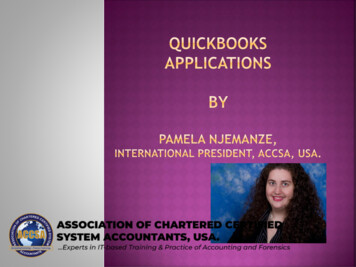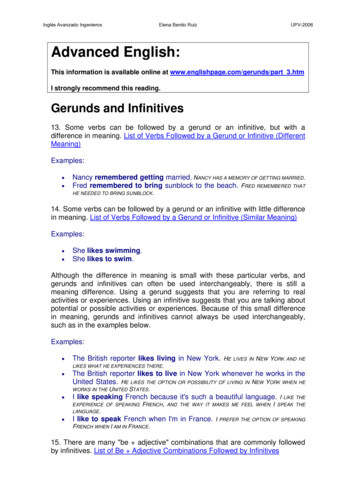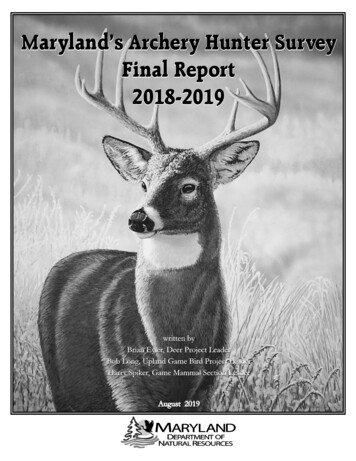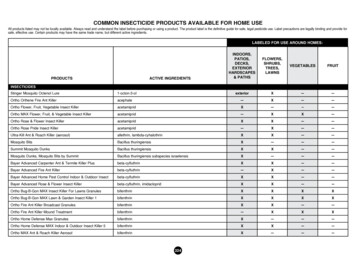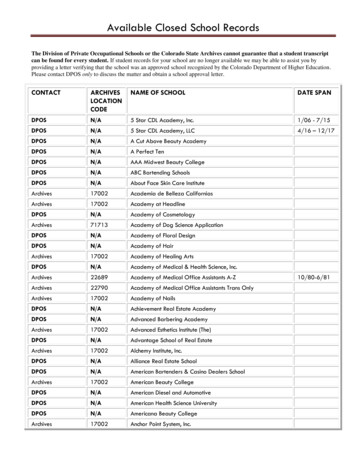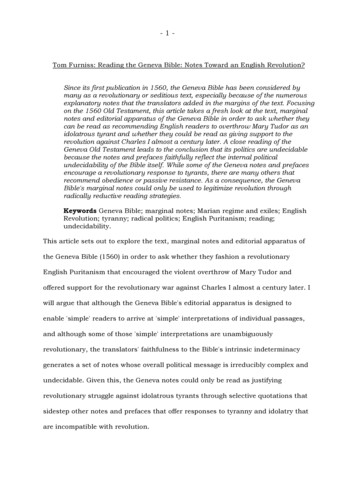
Transcription
-1-Tom Furniss: Reading the Geneva Bible: Notes Toward an English Revolution?Since its first publication in 1560, the Geneva Bible has been considered bymany as a revolutionary or seditious text, especially because of the numerousexplanatory notes that the translators added in the margins of the text. Focusingon the 1560 Old Testament, this article takes a fresh look at the text, marginalnotes and editorial apparatus of the Geneva Bible in order to ask whether theycan be read as recommending English readers to overthrow Mary Tudor as anidolatrous tyrant and whether they could be read as giving support to therevolution against Charles I almost a century later. A close reading of theGeneva Old Testament leads to the conclusion that its politics are undecidablebecause the notes and prefaces faithfully reflect the internal politicalundecidability of the Bible itself. While some of the Geneva notes and prefacesencourage a revolutionary response to tyrants, there are many others thatrecommend obedience or passive resistance. As a consequence, the GenevaBible's marginal notes could only be used to legitimize revolution throughradically reductive reading strategies.Keywords Geneva Bible; marginal notes; Marian regime and exiles; EnglishRevolution; tyranny; radical politics; English Puritanism; reading;undecidability.This article sets out to explore the text, marginal notes and editorial apparatus ofthe Geneva Bible (1560) in order to ask whether they fashion a revolutionaryEnglish Puritanism that encouraged the violent overthrow of Mary Tudor andoffered support for the revolutionary war against Charles I almost a century later. Iwill argue that although the Geneva Bible's editorial apparatus is designed toenable 'simple' readers to arrive at 'simple' interpretations of individual passages,and although some of those 'simple' interpretations are unambiguouslyrevolutionary, the translators' faithfulness to the Bible's intrinsic indeterminacygenerates a set of notes whose overall political message is irreducibly complex andundecidable. Given this, the Geneva notes could only be read as justifyingrevolutionary struggle against idolatrous tyrants through selective quotations thatsidestep other notes and prefaces that offer responses to tyranny and idolatry thatare incompatible with revolution.
-2-Some critics have reiterated the assumption of many early modern readers that theGeneva Bible is a radical text that gave support to revolutionary ideas andmovements in England in the sixteenth and seventeenth centuries. For most ofthese critics, the marginal notes are the main source of this radicalism. Winthrop S.Hudson argues that the Geneva Bibleprovided an excellent medium by which to popularize [the Marian exiles']political ideas, and in marginal notes they brought attention to biblical proofsfor such concepts as an elective kingship, a compact between the ruler andthe ruled, the subjection of magistrates to the law, and the right of activeresistance and even of tyrannicide. (John Ponet, 184-5)Hudson concludes that 'There can be no doubt that, among generations ofEnglishmen, both in England and in America, these belligerent marginal notesserved to make current coin of revolutionary political principles' (John Ponet, 186).Despite Hudson's confidence, there is an on-going scholarly dispute about thepolitical orientation of the Geneva Bible's editorial apparatus. Gerald Hammond, forexample, argues that although the notes are theologically Calvinist they are notpolitically controversial:In essence the Geneva Bible's notes combine the scholarly and the popular,and they seldom glance at anything that could be called seditious.Doctrinally, their position is entirely what would be expected, Protestant,Calvinist, anti-Catholic. . But such notes are far outnumbered by those thatare aimed at revealing to the people the nature of the original text and, whereit is obscure, its meaning. (Making of the English Bible, 94)
-3-Such differences lead Lloyd E. Berry to suggest that 'much remains to be done inanalyzing the theological and historical implications of the marginal notes' of theGeneva Bible.1 In response to this suggestion, I want to take a fresh look at theGeneva Bible's political orientation, asking in particular whether the text andcritical apparatus can be seen as offering a revolutionary solution to the crisis ofthe Marian regime that, in turn, could become applicable to later political crisessuch as the English Civil War.I. Research Leave in GenevaDuring her brief reign from July 1553 to November 1558 Mary Tudor attempted tobreak the fragile and recently-forged link between English national identity andProtestantism by dismantling the Reformation in England. Her first Parliamentrepealed the Protestant legislation of Edward VI and she released and restoredleading Roman Catholic churchmen and imprisoned their Protestant counterparts.While about three hundred lower class Protestants, and a few prominentchurchmen, were burned at the stake, more than eight hundred Protestants fromthe middle classes fled abroad to the Lutheran and Calvinist strongholds ofGermany and Switzerland. In cities such as Frankfurt, Strasburg, Zurich andGeneva, English theologians and scholars had the opportunity to encounter leadersof the European Reformation and to develop their religious and political thought'free for once from the inhibiting influences of an English government' (Dickens, TheEnglish Reformation, 339). Between 1553 and 1558, the exiles produced roughly onehundred and sixty publications, about one hundred and twenty of which werepublished in English and were intended to be smuggled into England to console orrally the oppressed population.2 The most important of these works radically
-4-transformed English political and theological thought, making the period ofcontinental exile a decisive episode in the formation of a discourse of revolutionaryEnglish Puritanism. The fact that the chosen people of the Old Testament aremarked out by a history of exile, martyrdom and the struggle to survive as apersecuted minority under an idolatrous regime offered a compelling interpretiveparadigm for the experience of English Protestants under Mary Tudor. That Marycould be seen as a 'foreign' tyrant, promoting antichristian idolatry and persecutingthose who held to the true faith, actually strengthened the imagined link betweenEnglish national identity and Protestantism and gave rise to the belief that the 'lastdays' envisaged in the Scriptures were fast approaching and that the English wereabout to play a special role in the final struggle.3 Some of the exilic publicationsexploit the idea that the English were an elect people in order to develop a Puritantheory of revolution, the central claim of which is that the people as a whole had theright and duty to overthrow idolatrous tyrants.4 John Ponet's A Short Treatise ofPolitike Power, And of the Obedience which subjectes owe to kynges and other civileGovernours, with an Exhortacion to all true naturall Englishe men (Strasburg, 1556)powerfully articulates such revolutionary assumptions, so much so that it wasrepublished in England in 1639 and 1642 when its arguments had becomepertinent once again.5 The title page of Christopher Goodman's How SuperiorPowers Oght to be Obeyd of their subjects: and wherin they may lawfully by GodsWorde be disobeyed and resisted (Geneva, 1558) announces that the work identifies'the cause of all this present miserie in England, and the onely way to remedy thesame'.6 For Goodman, as for Ponet, England has been handed over to tyranny andidolatry by all the institutions that ought to have protected the realm, and the onlyremedy is revolution. Ponet's and Goodman's assumption that the sufferings of the
-5-people of England somehow paralleled the sufferings of the chosen nation of the OldTestament thus allowed them to articulate revolutionary political ideas that went farbeyond the hesitant resistance theories of the mainstream Reformation and veeredtowards the dangerous ideas of the Radical Reformation. It was in this atmospherethat a group of English exiles in Geneva produced a new English translation of theBible that included marginal notes and other editorial matter that some readers inthe sixteenth and seventeenth centuries took to be as revolutionary as the tracts ofPonet and Goodman.The translation of the Bible into English in the early modern period was highlycontroversial, routinely equated with the promotion of sedition and heresy. TheConstitutions of Oxford of 1408, which decreed that 'Any unauthorized personcaught with a Wycliffe Bible could be tried for heresy', were still in force in the earlysixteenth century and the Lollards were still being persecuted (Bobrick, Making ofthe English Bible, 62). William Tyndale's piecemeal translations of the Bible in thelate 1520s and early 1530s had to be produced in exile and in defiance of thesecular and ecclesiastical authorities of Henrican England. When copies ofTyndale's New Testament were smuggled into England, Cardinal Wolsey headed acampaign of repression in which large numbers of copies were ceremonially burned.After Wolsey's fall in 1529, Thomas More continued the attack and a royalinjunction forbade buying or owning an English Bible. Readers who disobeyed thisinjunction were burned and Tyndale himself was captured and burnt as a heretic inOctober 1536. Even after Thomas Cromwell and Thomas Cranmer persuaded theking to license English Bibles on the assumption that they would help establishEngland's independence from Rome and bolster the king as head of state andchurch, there was some anxiety about allowing general readers outside the Church
-6-and the political elite to have access to a text that was seen as having radicalpolitical tendencies. As a consequence, 'for the century after the Reformation, theAnglican church did its best to smother the revolutionary message which someEnglish men and women read into it' (Hill, English Bible, 16). After Cromwell'sdownfall in July 1540, the conservatives encouraged the king in what A.G. Dickenscalls his 'experiment in Anglo-Catholicism' (English Reformation, 208). Protestantswere persecuted and sometimes burned, and the Act for the Advancement of TrueReligion (1543) attempted to abolish 'diversity of opinions' about scripturalinterpretation, condemned 'crafty false and untrue' (i.e., Protestant) translations,and sought to prohibit 'women, artificers, apprentices, journeymen, servingmenunder the degree of yeomen, husbandmen and labourers' from reading the Bible(quoted by Dickens, English Reformation, 213).The highly-charged history of biblical translation into English between the 1520sand the 1540s, along with the actions of the Marian regime and the radical writingsof the Marian exiles, might suggest that the exiles' decision to embark on a newtranslation of the Bible in the late 1550s was a politically motivated act. But it isalso possible to see the project as a response to the scholarly opportunity that exilein Geneva provided. Geneva was an ideal location for a new translation of the Bible:it was the centre of the Calvinist Reformation, it had the best printers in Europe,and it was 'a power-house of textual research and translation into Europeanvernaculars, of secular classics as well as of Scripture'.7 The Bible published inApril or May of 1560 as The Bible and Holy Scriptures Conteyned in the Olde andNewe Testament Translated According to the Ebrue and Greke, and conferred with thebest translations in divers langages (Geneva: Rouland Hall, 1560) quickly came to be
-7-regarded as 'a locus of Renaissance and Reformation scholarship, a triumph oftextual, theological, and linguistic excellencies, universally admired'.8There is general agreement among scholars that the Geneva Bible was produced bya group of exiles under the direction of William Whittingham, one-time Fellow of AllSouls and now Calvinist pastor of the English congregation at Geneva. An EnglishNew Testament, based largely on Tyndale, appeared in 1557 with explanatory notesand a prefatory epistle by John Calvin.9 When Mary Tudor died in November 1558,many of the exiles returned to England, eager to contribute to the renovation of theEnglish state and church under Elizabeth. But Anthony Gilby, William Cole andothers remained with Wittingham in Geneva 'to finish the work on the Bible and seeit though the press' (Berry, 8). The Boke of Psalmes was published in Geneva with adedicatory epistle to the new queen, dated 10 February 1559, which claims that theentire Bible was 'in good readines'.10 In the preface to the reader in the Geneva Bibleitself, dated 10 April 1560, the translators indicate that they had worked on thetranslation and editorial apparatus 'for the space of two yeres and more' (iiii, recto).Berry concludes from these indications that Whittingham's team of scholars 'hadbegun as early as 1556 to devote themselves to translating the Scriptures intoEnglish' and that the bulk of the work on the Bible was completed by 1558 (9, 8). Inother words, although the Geneva Bible was published about eighteen months intoElizabeth's reign, most of the translation and editorial apparatus appears to havebeen produced while Mary Tudor was still on the throne. Any reading of the politicsof the Geneva Bible needs to take this fact into account.II. Seditious and Traitorous Conceits
-8-The Geneva Bible marks the change of regime in England with a dedicatory epistle'To the Moste Vertuous and Noble Quene Elisabet' from her 'humble subjects of theEnglish Churche at Geneva' (ii, recto). Despite this dedication, the Geneva Biblenever became the official Bible of the Elizabethan church and had to be importedfrom Geneva until the death of Archbishop Matthew Parker in 1575. But between1575 and the first appearance of the King James version in 1611, the Geneva Biblewent through about a hundred English editions, becoming 'the most widely readbook of any kind in the Elizabethan era and into the seventeenth century'.11 Eventhe King James version 'did not immediately eclipse the popularity of the GenevaBible'; although it had to be smuggled into England from Amsterdam after 1616,'The extraordinary fact É is that over sixty editions (some, of the New Testamentonly) appeared after the Authorized Version' (Berry, 14).One of the main reasons for the Geneva Bible's popularity was its provision of asophisticated but user-friendly editorial apparatus (Berry, 13). The Geneva Bible isdesigned to be used by ordinary, non-expert readers. As Alister McGrath notes, the1560 edition 'was produced relatively cheaply (bringing it within the reach of manyfamilies). It was handsomely printed in an attractive typeface, and its relativelycompact size Ð quarto rather than folio Ð made it convenient for personal and familyuse' (In the Beginning, 119). This new English translation builds on Tyndale'sexample not only by returning to the original Hebrew and Greek, but also by beingdesigned, as David McKitterick puts it, 'to be read, as well as to be heard'(Cambridge Geneva Bible of 1591, x). The text was divided into numbered verses forthe first time, and each book and chapter is headed by a summary of the contents.The Geneva Bible's title page assures the reader that the text is embellished 'WithMoste Profitable Annotations upon all the hard places, and other things of great
-9-importance as may appeare in the Epistle to the Reader'. This Epistle explains thatthe editorial apparatus was added 'that by all meanes the reader might be holpen'(iiii, verso). Such comments are extremely significant. The notes and other editorialmaterial made accessible to ordinary readers the enormous learning andscholarship of the Geneva translators. Of the thousands of notes that crowd themargins of the text, many explain details of translation, many consist of crossreferences between books and between Testaments, and a good deal serve simply toexplicate the text Ð interpreting figurative language or spelling out ambiguities andalternative readings. At the end of the volume there is a table of Biblical names withexplanations of their meaning, a table of things contained (i.e., an index), and acomputation of the period of time between the creation of the world and thepublication of the Geneva Bible itself Ð information that was deemed vital formillenarian calculations. The Geneva Bible is also illustrated and interpreted byvisual aids, including twenty-six woodcut illustrations and five maps to help thereader understand the symbolic geography and journeys of the Jews and earlyChristians. The editors claim that their notes and illustrations serve simply toexplain and interpret the text:Forthermore whereas certeyne places in the bookes of Moses, of the Kingsand Ezekiel semed so darke that by no description thei colde be made easieto the simple reader, we have so set them forthe with figures and notes forthe ful declaration therof, that thei which can not by judgement, being holpenby the annotations noted by the lettres a b c. &c. atteyn thereunto, yet by theperspective, and as it were by the eye may sufficiently knowe the truemeaning of all suche places. (iiii, verso)
- 10 -Michael Jensen reads such pronouncements as evidence that the Geneva Bible wasdesigned to present a 'simple' reading for 'simple' readers ('"Simply" Reading theGeneva Bible', 30) Ð a suggestion that I will bring into question in the course of thepresent article.The Geneva Bible's use of a combination of verbal and visual aids has recently beenseen as an early modern equivalent of the search engine and as an importantdevelopment in the evolution of the book as an artifact (Corns, 'The Early ModernSearch Engine', 102-3). Yet the Geneva Bible was not unique or even unusual inthis respect since earlier and rival English translations, like their Lutheran andCalvinist models on the continent, also employed such technical and visual aids,prefatory material and marginal notes (see Green, Print and Protestantism in EarlyModern England, 66-79). What is distinctive about the Geneva Bible is the sheernumber of marginal notes and the fact that some of the notes and prefaceshighlight the fact that the Bible contains examples of resistance to oppressive kingsand the revolutionary overthrow of tyrants that are inspired by God. The politicallycontentious tendency of some of the Geneva Bible's marginal notes was one of themain reasons why it did not become the official Bible of the English church andwhy two official translations were produced to try to neutralize it. In amemorandum to the translators of the Bishop's Bible in 1568, Archbishop Parkerinsisted that they should 'make no bitter notis uppon any text, or yet to set downeany determinacion in places of controversie'.12 Forty years later, the 'King James'translation was designed to displace the Geneva Bible. Having been brought up onit by his tutor, George Buchanan, and having witnessed the way it was used tojustify the overthrow of his mother, James saw the Geneva Bible as an attack onmonarchy and the divine right of kings. At the Hampton Court Conference in
- 11 -January 1604, the king called the Geneva Bible 'the worst of all' Englishtranslations and gave permission for a new translation, with the caveatthat no Marginal Notes should be added, having found in them that areannexed to the Geneva translation . some Notes very partial, untrue,seditious, and savouring too much of dangerous, and traitorous conceits. Asfor example, the first Chapter of Exodus and the nineteenth Verse, where theMarginal Note alloweth Disobedience unto Kings. And 2. Chro. 15.16 the notetaxeth Asa for deposing his Mother, only, and not killing her.13These examples reveal why James found some of the Geneva notes problematic. Thefirst chapter of Exodus records that the King of Egypt had 'commanded themidwives of the Ebrewe women' to kill all male babies (1:15-16), but the midwives,fearing God, disobeyed the king; when the king demanded an explanation, themidwives claimed that they had not been able to kill the male babies becauseHebrew women tend to give birth before midwives are able to attend them (1:19).The Geneva marginal note makes the following comment: 'Their disobedie[n]ceherein was lawful, but their dissembling evil' (24, verso). The implication, then, asJames saw, is that subjects may disobey a king Ð at least if his command goesagainst God's laws or if he is a tyrant. The Geneva Bible and its notes continued tobe seen as a threat to monarchs and monarchists well into the seventeenth century,especially because of the way it was used by radicals in the revolutionary strugglesof the mid century. In 1648, Sir Robert Filmer, in order to discredit the use of theGeneva Bible to label Charles I as a tyrant, noted thatthe words [tyrant and slave] are frequent enough in every man's mouth, andour old English translation of the Bible useth sometimes the word tyrant. But
- 12 -the authors of our new translation have been so careful, as not once to usethe word, but only for the proper name of a man Ð Acts xix, 9 Ð because theyfind no Hebrew word in the Scripture to signify a tyrant or a slave. (Anarchyof a Limited or Mixed Monarchy, 147-48)As late as 1670, twenty years after the Revolution, Peter Heylyn, chaplain toCharles I and Charles II, asserted that James I and VI had rightly judged that theGeneva notes 'in many places savour of Sedition, and in some of Faction,destructive of the Persons and Powers of Kings, and of all civil intercourse andhumane society' (Aerius Redivivus, 247).The two Geneva notes that James I and VI identifies as seditious in the HamptonCourt Conference are both taken from the Geneva Old Testament. In what follows, Ifocus almost entirely on the Geneva Old Testament, mainly because the GenevaNew Testament is significantly less radical than the Geneva Old Testament. ForHudson, the Geneva Bible's politically radical notes are mostly to be found in theOld Testament 'owing to the fact that the translation of the New Testament, firstpublished in 1557, was made before the translators had begun to think along thesemore radical lines' Ð that is, before Ponet's and Goodman's revolutionary tractscould have had an impact on the Geneva translators (John Ponet, 185, n.13). It isalso the case that the political context explored in the New Testament is quitedifferent from that in the Old Testament. Whereas the Old Testament is obsessedwith the relationship between the people of Israel and the kings, tyrants andoppressors who rule over them, the New Testament is concerned with working outhow small communities of Christians can survive within the Roman Empire. Thelatter question is one of the main issues that St Paul attends to in his epistle to the
- 13 -Christians in Rome, in which he recommended them to 'be subject unto the higherpowers: for there is no power but of God: and the powers that be are ordeined ofGod' (Romans 13:1).Before I go on to develop a close reading of the Geneva Old Testament, however, it isimportant to note that the text and notes of the Geneva New Testament wentthrough two significant reincarnations between the publication of the first edition ofthe Geneva Bible in 1560 and the end of the sixteenth century:In 1576, the Puritan Lawrence Tomson, scholar, member of Parliament, andaide to Sir Francis Walsingham, brought out an edition of the Genevan NewTestament. Although there were some revisions in the text, mainly from[Theodore] Beza's later work, the substantial changes were in the marginalnotes, which were based on those of Beza and Camerarius in the 1573edition of the Greek New Testament edited by Pierre Loisseleur de Villiers. In1587 a quarto edition of the Geneva Bible was brought out with Tomson'sNew Testament and notes substituted for those in the 1560 edition, and fromthis time on some editions had the Tomson and some the original notes.Another important addition was the commentary of Franciscus Junius on thebook of Revelation, translated in 1592 from Latin into English. These notes,extremely anti-Catholic, were first appended to Tomson's New Testament,then to some editions of the Geneva Bible, and from 1599 on replaced theoriginal notes on Revelation in the Geneva Bible. (Berry, 14-15)In the early part of the seventeenth century, then, there were several differentversions of the Geneva Bible in circulation and any discussion of the politicalimplications and potential impact of the Geneva Bible in the period between 1560
- 14 -and the revolutionary wars of the 1640s has to take this into account. Yet inassessing the impact of these changes to the Geneva New Testament, it is worthremembering that the two Geneva notes that James I and VI identified as seditiousin the Hampton Court Conference were both taken from the Geneva Old TestamentÐ which remained unchanged throughout the Geneva Bible's publication history. Itshould also be said that the New Testament notes of Beza and Camerarius are notobviously more politically radical than the 1560 notes and that Junius's notes toRevelation are less concerned with the political relationship between princes andpeople than with presenting 'a massive and violent antipapal diatribe' (Betteridge,'The Bitter Notes', 45).14 I would therefore suggest that the various transformationsthat the Geneva New Testament underwent did not significantly modify the GenevaBible's potential impact on the English Revolution of the 1640s and that ourprimary focus in this regard should be on the text and annotations of the OldTestament.III. Reading the Geneva BibleThe most significant tendency of the Geneva Bible's editorial apparatus is toencourage its readers to make direct connections between what they read about theOld Testament Jews or early Christians and their own contemporary situation inEngland. As John R. Knott puts it, 'The habit of identifying with the experiences ofthe Israelites, by an essentially ahistorical leap to the truth of the Word, pervadesthe Geneva Bible' (Sword of the Spirit, 29). This reading strategy draws on one of thefounding myths of English radicalism Ð the idea that the people of England mightbe a post-biblical equivalent to the chosen people of the Old Testament. Despite thefact that the Geneva note to Revelation 22:2 asserts that 'Christ who is the life of
- 15 -his Church, is commune to all his and not peculiar for any one sorte of people'(122, recto), the 'Epistle to the Reader' that follows the dedication to Elizabethinvites 'our Beloved in the Lord the Brethren of England, Scotland, Ireland, &c' tocompare their lot with that of the Old Testament Jews. Although the people ofBritain (especially the English) have been severely persecuted they have not yetsuffered the fate of the children of Israel, who so betrayed the trust of God that theywere and remain scattered throughout the world:we are especially bounde (deare brethren) to give [God] thankes withoutceasing for his great grace and unspeakable mercies, in that it hath pleasedhim to call us unto this mervelous light of his Gospel, & mercifully to regardeus after so horrible backesliding and falling away from Christ to Antichrist,from light to darckness, from the living God to dumme and dead idoles, &that after so cruel murther of Gods Saintes, as alas, hathe bene among us,we are not altogether cast of, as were the Israelites, and many others for thelike, or not so manifest wickednes, but receyved agayne to grace with mosteevident signes and tokens of Gods especial love and favour. (iiii, recto)This analysis of England's recent history suggests that the Marian tyranny was aperiod in which the chosen people of England fell into national sin and that Mary'soverthrow and her replacement by a godly queen is a sign of God's special graceand mercy to His favored people. Indeed, the Geneva Bible itself is now being offeredas a gift of God that will enable His own people to become worthy once more of Hisfavor (iiii, verso).The establishment of parallels between the experiences of the Old Testament Jewsand the current situation of the people of England underlies the implicit meanings
- 16 -of the Geneva Bible's frontispiece. The woodcut illustration of the Red Sea incidentin Exodus that forms part of the frontispiece apparently serves as a visual key tothe Geneva Bible's whole ideological project:A critical moment in the account in Exodus of the children of Israel's flight from theEgyptians is vividly illustrated by an image of the Jews facing the Red Sea, hemmedin by mountains on either side and with the Egyptians hard on their heels. Thepillar of cloud can be seen above the sea, but the sea has not yet parted. In otherwords, the Jews appear to be at the point of destruction at the hands of theirenemies, but are about to be saved, and their enemies destroyed, by a spectacularintervention by their God that would confirm once more their special status as
- 17 -God's chosen people. The parallels between the situation of the Jews at thismoment and that of English Protestants would have been vivid to contemporaryreaders who were already primed to think of the agents of Marian tyranny as'idolatrous Egyptians'.15 Elizabeth's accession is thus made equivalent to the RedSea miracle Ð an epochal event in the formation of the children of Israel into anation. For the Geneva Bible's first readers in England, Mary's sudden death andElizabeth's accession would have seemed a striking confirmation of thereassurances presented in the biblical quotations that surround the frontispieceillustration and that appear to spell out the text's theological-ideological standpointregarding the question of the appropriate response to tyranny. Above and below theimage are quotations from Exodus: 'Feare ye not, stand stil, and beholde thesalvacion of the Lord, which he wil shewe to you this day. Exod.14,13'; 'The Lordshal fight for you: ther
Geneva Bible is a radical text that gave support to revolutionary ideas and movements in England in the sixteenth and seventeenth centuries. For most of these critics, the marginal notes are the main source of this radicalism. Winthro
